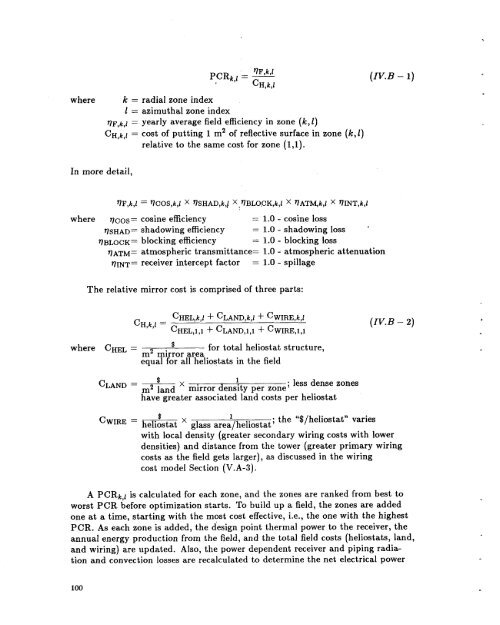A User's Manual for DELSOL3 - prod.sandia.gov - Sandia National ...
A User's Manual for DELSOL3 - prod.sandia.gov - Sandia National ...
A User's Manual for DELSOL3 - prod.sandia.gov - Sandia National ...
You also want an ePaper? Increase the reach of your titles
YUMPU automatically turns print PDFs into web optimized ePapers that Google loves.
‘?F,k,l<br />
PCRk,l = -<br />
, CH,k,l<br />
where k = radial zone index<br />
1 = azimuthal zone index<br />
VF,~,J = yearly average field efficiency in zone (IC, I )<br />
CH,k,l = cost of putting 1 m2 of reflective surface in zone (k,l)<br />
relative to the same cost <strong>for</strong> zone (1,l).<br />
In more detail,<br />
‘?F,k,l = ’?COS,k,l x ‘?SHAD,k,/ Xh’?BLO,CK,k,l x ‘?ATM,k,l x ‘?INT,k,l<br />
where ‘?cos= cosine efficiency = 1.0 - cosine loss<br />
‘?SHAD= shadowing efficiency = 1.0 - shadowing loss *<br />
‘?BLOCK= blocking efficiency = 1.0 - blocking loss<br />
VAT-= atmospheric transmittance= 1 .O - atmospheric attenuation<br />
QINT= receiver intercept factor = 1.0 - spillage<br />
The relative mirror cost is comprised of three parts:<br />
CHEL,k,f + CLAND,k,f + CWIRE,k,l<br />
CH,k,l =<br />
CHEL,~,~<br />
+ CLAND,~,~ + CWIR.E,~,~<br />
where CHEL = $ <strong>for</strong> total heliostat structure,<br />
m2 mirror area<br />
equal <strong>for</strong> all heliostats in the field<br />
$ 1<br />
* less dense zones<br />
= ,2 ]and mirror density per zone’<br />
have greater associated land costs per heliostat<br />
$ x 1 * the “$/heliostat” varies<br />
(1V.B - 2)<br />
= heliostat glass area/heliostat’<br />
with local density (greater secondary wiring costs with lower<br />
densities) and distance from the tower (greater primary wiring<br />
costs as the field gets larger), as discussed in the wiring<br />
cost model Section (V.A-3).<br />
A PCRk,l is calculated <strong>for</strong> each zone, and the zones are ranked from best to<br />
worst PCR be<strong>for</strong>e optimization starts. To build up a field, the zones are added<br />
one at a time, starting with the most cost effective, i.e., the one with the highest<br />
PCR. As each zone is added, the design point thermal power to the receiver, the<br />
annual energy <strong>prod</strong>uction from the field, and the total field costs (heliostats, land,<br />
and wiring) are updated. Also, the power dependent receiver and piping radia-<br />
tion and convection losses are recalculated to determine the net electrical power<br />
100

















